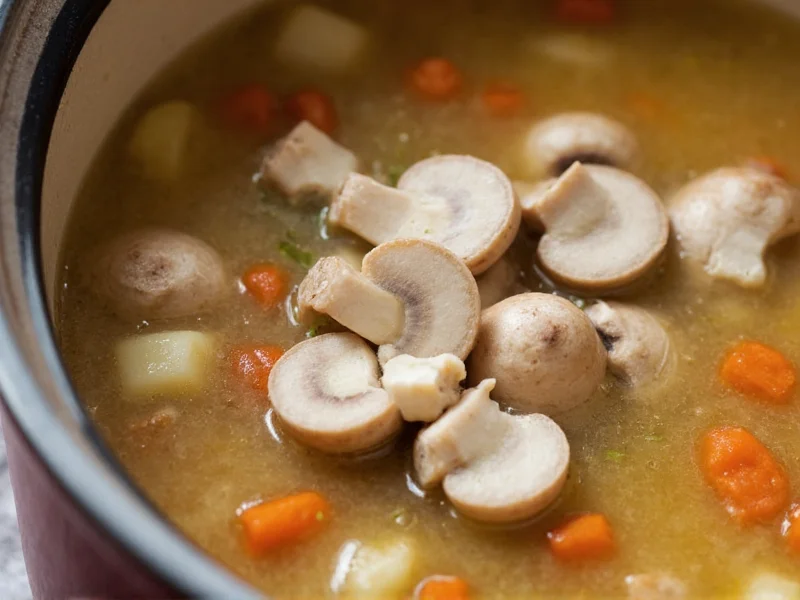Choosing the right mushrooms makes or breaks your mushroom soup. Many home cooks settle for basic white buttons, unaware they're missing out on the rich, complex flavors professional chefs achieve. The secret lies not in a single variety but in strategic blending of complementary mushrooms that create layered umami depth impossible with one type alone.
Top Mushroom Varieties for Exceptional Mushroom Soup
Understanding each mushroom's unique contribution helps you craft soups with professional-level complexity. Here's how the top varieties perform in soup applications:
| Mushroom Variety | Flavor Profile | Texture When Cooked | Best Soup Application | Availability |
|---|---|---|---|---|
| Cremini (Baby Bella) | Earthy, woodsy, deeper than white button | Firm, holds shape well | Base for most mushroom soups | Year-round, grocery stores |
| Shiitake | Rich umami, smoky, bacon-like notes | Slightly chewy, meaty | Adding depth to creamy mushroom soup | Year-round, most supermarkets |
| Dried Porcini | Intensely earthy, nutty, concentrated umami | Dissolves into broth | Flavor foundation for mushroom varieties soup | Year-round, specialty stores |
| Oyster | Mild, delicate, slightly sweet | Tender, melts into broth | Lighter mushroom soup variations | Seasonal, farmers markets |
| Chanterelle | Fruity, apricot-like, complex | Firm yet tender | Premium mushroom soup recipes | Seasonal, specialty stores |
Why Mushroom Blending Creates Superior Flavor
Professional chefs never rely on a single mushroom variety when making mushroom soup. Each type contributes different flavor compounds that combine to create complexity impossible with one variety. The science behind this is simple: different mushrooms contain varying levels of glutamates, guanylates, and other umami compounds that work synergistically.
For the most flavorful mushroom soup for beginners, start with this reliable ratio: 60% cremini, 30% shiitake, and 10% dried porcini. The cremini form your flavor base, shiitake add meaty depth, while the porcini—reconstituted in warm water—infuse the broth with intense mushroom essence. This combination works for traditional cream of mushroom soup, vegan mushroom soup, and even wild mushroom soup variations.
Proper Preparation Techniques for Maximum Flavor
How you handle mushrooms significantly impacts your soup's final flavor. Never wash mushrooms under running water—this makes them waterlogged and dilutes flavor. Instead, wipe cremini and shiitake with a damp cloth. For dried porcini, steep in 175°F water for 20 minutes, then strain through cheesecloth (saving the liquid for your broth).
The critical step many home cooks miss is proper sautéing. Cook mushrooms in batches over medium-high heat without crowding the pan. Let them develop a deep golden-brown crust before stirring—this Maillard reaction creates hundreds of new flavor compounds. Only after they've released their water and reabsorbed it should you add aromatics like shallots and garlic.
Seasonal Considerations and Smart Substitutions
Fall offers the widest selection of fresh mushrooms for mushroom soup recipes, but you can create excellent soups year-round with smart substitutions. When fresh wild mushrooms are unavailable, dried porcini or morels provide concentrated flavor. Frozen wild mushrooms work better than out-of-season fresh varieties that have traveled long distances.
If you can't find shiitake for your creamy mushroom soup, substitute with oyster mushrooms and add a splash of soy sauce to boost umami. For vegan mushroom soup that mimics meaty depth, combine cremini with a small amount of dried shiitake powder. Remember that dried mushrooms always need rehydration before use—their concentrated flavor makes them indispensable for mushroom soup from scratch.
Flavor Pairing Strategies for Gourmet Results
Elevate your mushroom soup beyond basic recipes with strategic pairings. Thyme and rosemary complement earthy mushrooms, while a splash of sherry or Madeira wine enhances umami. For restaurant-style mushroom soup, finish with a knob of cold butter swirled in at the end—a technique that creates luxurious texture without overwhelming mushroom flavor.
Consider your soup's final texture when selecting mushrooms. For smooth cream of mushroom soup, blend cooked mushrooms thoroughly. For chunky wild mushroom soup, reserve some sautéed pieces to add at the end. The best mushroom soup for cold weather often includes a touch of smoked paprika or a Parmesan rind simmered in the broth for added complexity.
Frequently Asked Questions
Can I use only white button mushrooms for mushroom soup?
Yes, but the flavor will be significantly less complex. White buttons lack the deep umami of cremini and shiitake. For better results, use at least 50% cremini mushrooms with white buttons, and add dried porcini to boost flavor. The best mushroom soup always features multiple varieties for layered taste.
How do I prevent my mushroom soup from becoming watery?
Mushrooms release significant water when cooked. To prevent watery mushroom soup, sauté mushrooms in batches until all liquid evaporates and they develop a deep golden color. This concentrates flavor and removes excess moisture. For cream of mushroom soup, use a roux or puree some mushrooms to naturally thicken the broth without flour.
What's the secret to making mushroom soup taste restaurant-quality?
The professional secret is using dried mushrooms. Reconstitute 0.5 ounces of dried porcini in 2 cups warm water, then strain and use this intensely flavored liquid as your broth base. Combine with fresh cremini and shiitake sautéed until deeply browned. Finish with a splash of sherry and cold butter for that signature restaurant mushroom soup richness.
Can I make mushroom soup with frozen mushrooms?
Yes, frozen mushrooms work well for soup, especially when fresh wild varieties aren't available. Thaw completely and squeeze out excess water before sautéing. Frozen mushrooms often work better than out-of-season fresh mushrooms that have traveled long distances. For best results in mushroom soup from frozen ingredients, combine with dried porcini to boost flavor depth.
How long does homemade mushroom soup stay fresh?
Properly stored in an airtight container, mushroom soup stays fresh for 3-4 days in the refrigerator. The flavor often improves overnight as ingredients meld. For longer storage, freeze in portion-sized containers for up to 3 months. Cream-based mushroom soups may separate when frozen—stir vigorously while reheating and add a splash of cream if needed.











 浙公网安备
33010002000092号
浙公网安备
33010002000092号 浙B2-20120091-4
浙B2-20120091-4